Most people take for granted the importance of having healthy and efficient functions. There is an extensive network of veins and arteries found throughout the human body, all of which make up an essential part of our body’s health. Veins affect so many primary systems within our body, so taking notice of these changes and giving them serious attention is extremely important. While it’s often little more than a cosmetic issue when dealing with spider veins, it’s always worth it to double-check with your doctor.
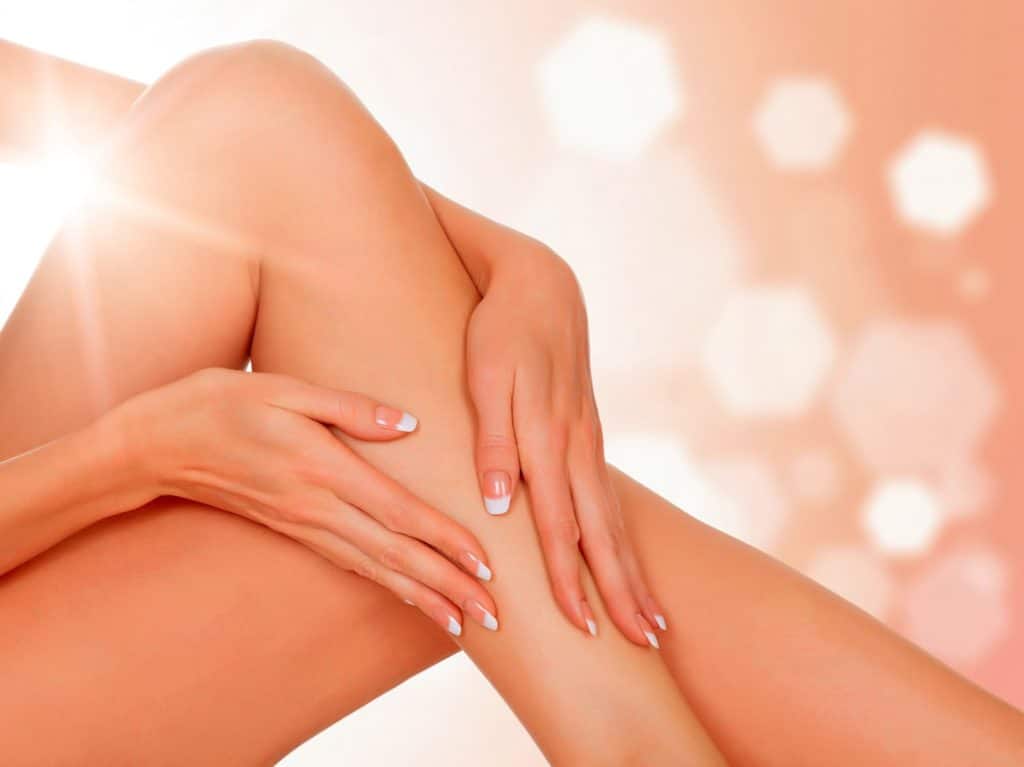
Veins vs. Arteries
Veins and arteries must work together in perfect harmony in order to carry blood back and forth between our body’s extremities (legs, arms, hands, feet), and our heart. Arteries carry oxygen-rich blood away from the heart, and veins then return oxygen-depleted blood from the rest of the body back to the heart to be restored and then recirculated through the body. The process is ongoing and unending, and a cornerstone of how we function every single day.
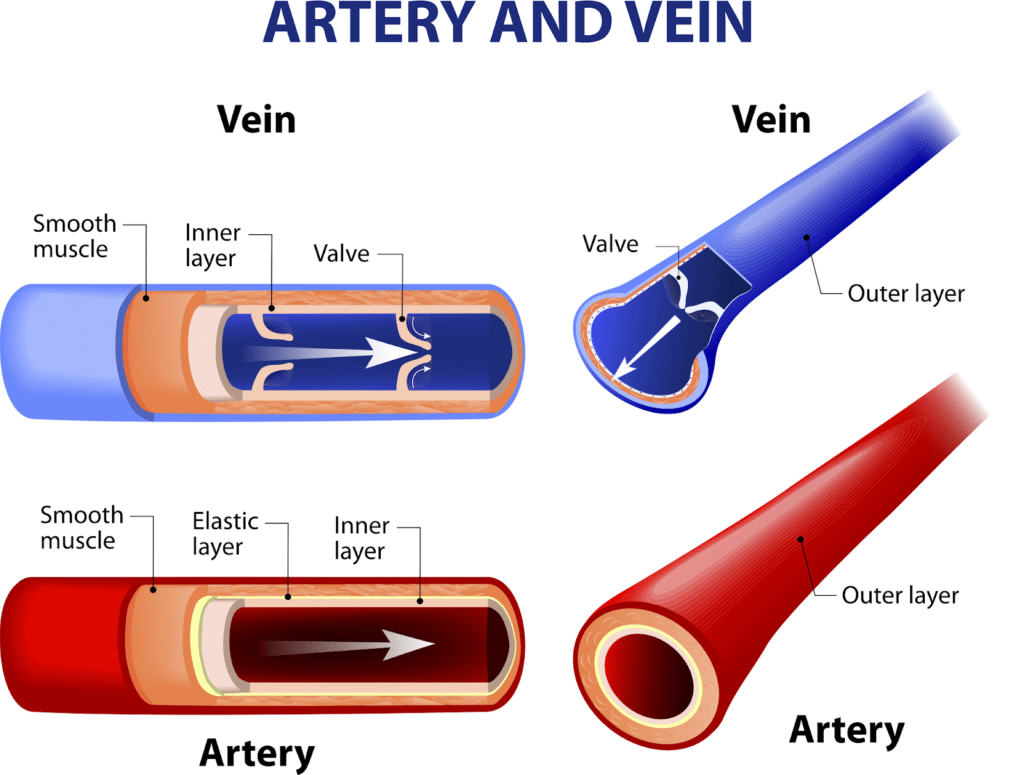
While both the functions of arteries and veins are vital to our health and wellbeing, gravity makes it more difficult for veins to function efficiently when trying to move our blood flow upwards, back towards the heart. Unlike arteries, which have a heart which pumps blood into them, veins are dependent on receiving propulsion from the muscles that surround them. This is why the valves are critical.To help with this process and to push against the gravity working against them, each vein has a collection of one-way valves, helping the vein push blood upwards and in the right direction. When one of these valves isn’t working properly, blood can quickly start to pool in the extremities. As this pooling continues, it may cause pressure to build, swelling to begin, and may lead to the development of varicose veins.
Varicose Veins vs. Spider Veins
Varicose veins, also referred to as chronic venous insufficiency, are larger than spider veins, and are more likely to cause serious pain, discomfort, and medical issues for those who have them. They bulge out from the surface of the skin and appear swollen, lumpy, or tangled. This chronic form of venous insufficiency may be accompanied by a range of painful side effects, such as aching, burning, rashes, restlessness, muscle cramping, and fatigue. They require prompt treatment, otherwise, they may lead to ulcers, blood clots, or other dangerous conditions.
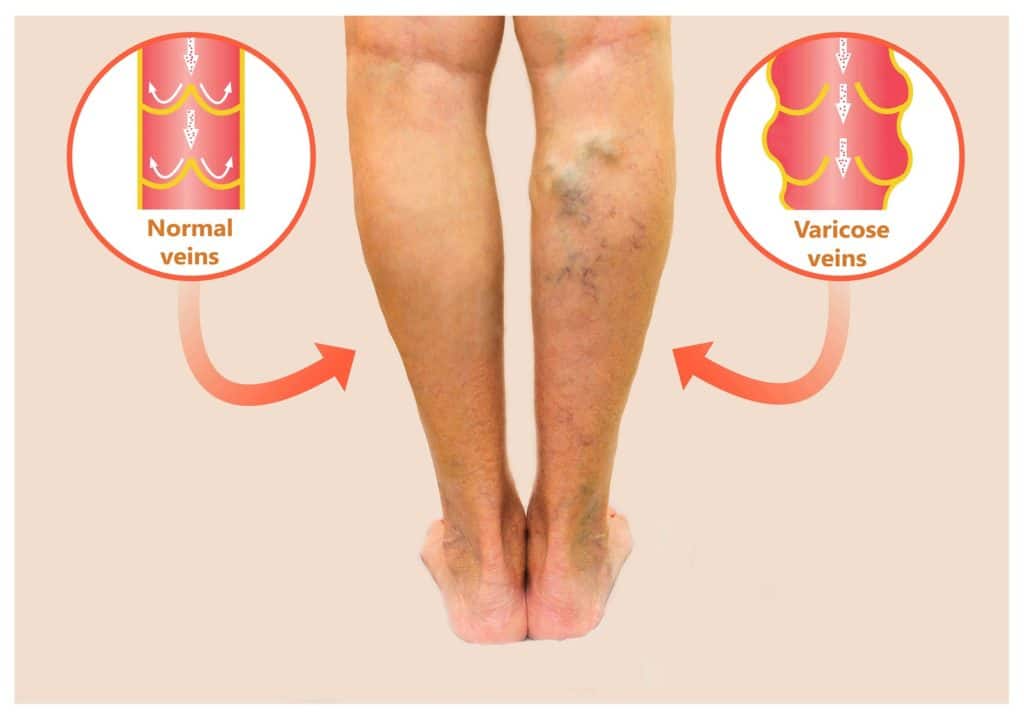
On the other hand, Spider veins are extremely thin veins right at the surface of the skin, and they get their namesake from the spider appearance they make, circular in shape with long, thin legs running outward from the center. Unlike varicose veins, they rarely cause discomfort to those who have them but do cause frustration over their cosmetic appearance. Often referred to as spider veins, “capillary veins”, or “broken veins”, spider veins are vessels near the surface of the skin that commonly show up on the nose, cheeks, chin, and underneath the eyes. Broken blood vessels occur when they’re dilated –or enlarged– just beneath your skin’s surface. These veins are usually bright blue or red and appear in clusters, and may cause you to appear “flushed” in the affected areas.
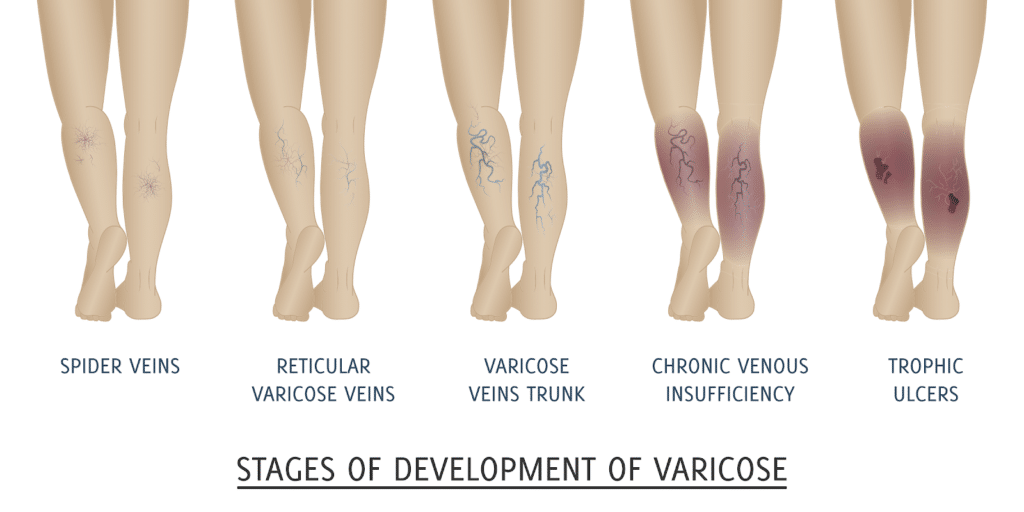
A frustrating cosmetic problem for those affected, these vein patterns will not disappear on their own. In these cases, patients who suffer from this condition may consider spider vein treatment as an option for reducing or removing their appearance. The good news is that spider veins are typically treatable, but you first need to figure out the underlying cause. Some people tend to develop spider veins more than others, and there are several factors that may contribute to who develops them and when.
Causes of Spider Veins
Causes of spider veins can be anything from a family history of experiencing these types of veins, or genetics that include risk factors that contribute to their development. Some women develop spider veins in their face as well as other areas of their body during and after pregnancy when their estrogen hormone levels increase, leading to broken blood vessels. Since the body produces more estrogen during pregnancy, women may suffer vein weakness, blood flow is also increased, and her veins may become enlarged.

The enlarged veins may cause blood to clog the vessels, hence the broken blood vessels form. Skin conditions like rosacea can lead to flushed-looking skin and broken blood vessels in the face, and so can excessive sun exposure. The list of possible causes is pretty long! Other examples of causes of spider veins can be any of the following:
- Weather changes and hot temperatures may increase blood vessel dilation and bursts.
- Sun exposure over time can lead to broken vessels.
- Environmental or chemical irritants in the air around you may irritate the skin enough to cause a rash or burst blood vessels.
- The consumption of moderate or occasional alcohol can cause your skin to flush due to your blood vessels getting larger, and binge drinking or consistently heavy drinking habits can even lead to spider veins!
- Injuries that lead to bruising on your face may also include more visible broken blood vessels.
- Vomiting or sneezing constantly can create extreme pressure in your face, which has been known to break blood vessels in the skin (and sometimes in the eyes).
- General aging and thinning of the skin on your face also causes your veins to weaken, which may lead to spider veins.
How Are Spider Veins or Broken Blood Vessels Diagnosed?
Everybody is different, and determining the cause of your spider veins can best be determined by speaking with your doctor to help hone in on the underlying cause. While you might be able to easily identify broken blood vessels simply by looking in the mirror, it’s always important to consult a medical professional to ensure there’s nothing more serious going on. Then, while you’re at it, you can discuss treatment options! Treating these unsightly spider veins might be easier than you think for your given condition. For most of Dr. Wright’s patients, spider vein treatment is quick and easy!
How Can You Prevent Spider Veins?
While treating broken blood vessels on your face may be a priority, consider preventive measures for future spider veins, too! Follow the guidelines below to help prevent spider veins in the future. Hint: Many of these action items are simply ways to avoid the causes we mentioned above.
- If you’re currently undergoing treatment for rosacea, stick with your plan and see your doctor if your skin doesn’t make any improvement.
- Limit your exposure to the sun’s powerful UV rays, especially during peak afternoon hours, and always wear your sunscreen.
- Avoid extreme heat, both weather-related while outdoors and even from saunas, spas, or extremely hot indoor areas.
- Only consume alcoholic beverages in moderation, and always ask your doctor if you should limit your intake even more (refrain from alcoholic beverages completely).
- Protect your body from injury wherever possible. Wear protective gear such as helmets and padding for sports and biking, and wear necessary braces or other protective gear when physically active. Wearing protective gear.
- Wash your face with warm water only, take warm baths or showers, and make sure the water isn’t too hot! Since heat can cause broken blood vessels, you’ll want to make sure you avoid hot water where you can.
Natural Remedies for Spider Veins
Many people prefer to first find natural remedies for their spider veins before seeking additional cosmetic treatments. Make sure you aren’t allergic or sensitive to anything on this list before trying it, and as always, consult your doctor if you aren’t sure! Additionally, if you have spider veins in sensitive areas, such as close to your eyes, be extremely careful not to get any of the ingredients in your eyes or nose! These remedies may be worth a try but they are usually not that effective.
- Diosmin is a type of plant flavanoid which is an extract of citrus fruits. Diosmin supplements and prescription diosmin has been shown to help with pain and inflammation caused by varicose is used for treating various disorders of blood vessels including hemorrhoids, varicose veins, poor vein circulation in the legs and its skin changes or chronic venous stasis.
- Apple cider vinegar for spider veins may help diminish the appearance and redness in the affected areas. Simply substitute the vinegar for your normal spider toner, and apply it gently using a cotton ball. This is an easy remedy to find in any grocery store, and we always recommend purchasing the version with “The Mother”.
- Horse chestnut for spider veins has also been successful for some people. This is a native tree to parts of southeastern Europe and has seeds that look similar to chestnuts (hence the name). The National Center for Complementary and Integrative Health recommends using the seed extract to help address and alleviate poor blood flow, which we know can lead to broken blood vessels. Look for this herbal remedy in topical form (rather than a supplement you take orally), and apply this to the affected area.
- Retinoids for spider veins may also be helpful in topical cream form as well. While primarily used for acne or rosacea, they naturally remove the outermost layer of your skin, which can lessen the appearance of the spider veins.
Cosmetic Treatments for Spider Veins
When natural remedies don’t work, it might be time for you to consider seeing a cosmetic doctor specializing in venous insufficiency for a medical and cosmetic solution. Luckily, there are several options available for most patients suffering from frustrating spider veins!
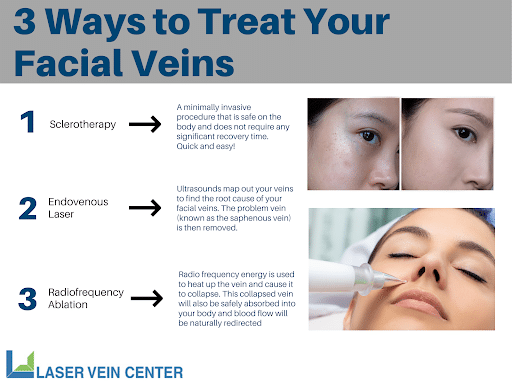
Sclerotherapy for Spider Veins
Sclerotherapy is a spider vein cosmetic treatment that is frequently requested by our patients. This treatment option is a quick and permanent way to address the culprit of your spider veins: the veins that had previously dilated and led to the burst. Dr. Wright injects your spider veins with a substance called a sclerosant. This chemical works by causing the dilation of your vein to diminish, and the vein will permanently shut and be naturally absorbed back into the body. Typically, our patients will receive multiple injections during their treatment for maximum results. Occasionally we will use a saline solution in place of the sclerosant with the same results and effectiveness.
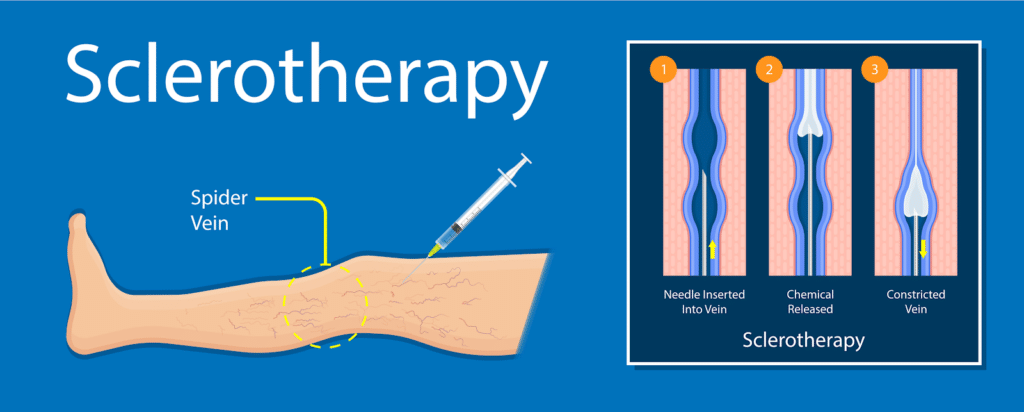
Sclerotherapy is the most recommended treatment for spider veins due to its precise nature. Other forms of vein disease, such as varicose veins, involve the bodies of larger veins. It is much easier to find these veins and treat them effectively, but spider veins are significantly smaller! Because of their tiny and thin size (sometimes these veins are as small as a needle tip!) it can be difficult for other forms of treatment. Sclerotherapy is also a minimally invasive procedure that is safe on the body and does not require any significant recovery time. In fact, most patients are able to get up and leave right after their procedure is over. Some patients may experience mild side effects such as an allergic reaction or inflammation after the procedure is completed, but these side effects typically fade within a day or two.
Endovenous Laser Treatment for Varicose Veins
One of our most popular and common vein treatments is endovenous laser treatment. This type of procedure maps out your veins with ultrasound mapping to find the root of the problem. The problem vein (known as the saphenous vein) is then removed. Older treatments required vein stripping that physically removed the vein from the body. However, endovenous laser treatment uses state of the art technology to safely shut down these problem veins. Specifically, Dr. Wright uses a small fiber that’s inserted into the damaged vein and directs laser energy at it. This causes the vein to permanently collapse and then be reabsorbed back into the body.
Endovenous laser treatment is a minimally invasive treatment meaning you will not have to go through lengthy recovery times. Local anesthesia makes sure you remain comfortable. Only a small incision is needed for the procedure and will heal quickly, and we use compression stockings to help accelerate the healing process.
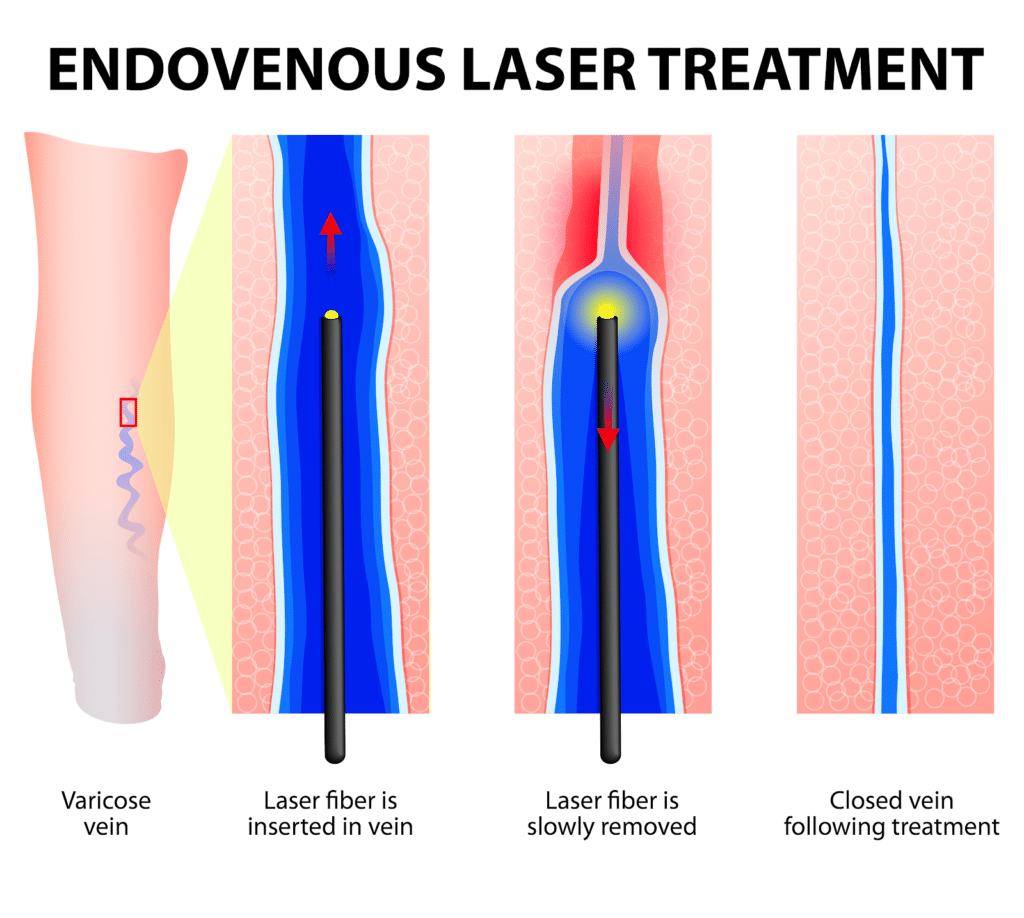
Radiofrequency Ablation
Another option that works similar to endovenous laser treatment is called radiofrequency ablation. This procedure also uses a tiny probe and is inserted into the problem vein. Instead of laser energy, this procedure will direct radiofrequency energy to heat up the vein and cause it to collapse. This collapsed vein will also be safely absorbed into your body and blood flow will be naturally redirected. After the treatment is complete your treatment area will start to regain its previous appearance. Most individuals can head home right after the treatment is complete. The usual side effects include some swelling around the treated area but will heal quickly especially when compression stockings are worn.
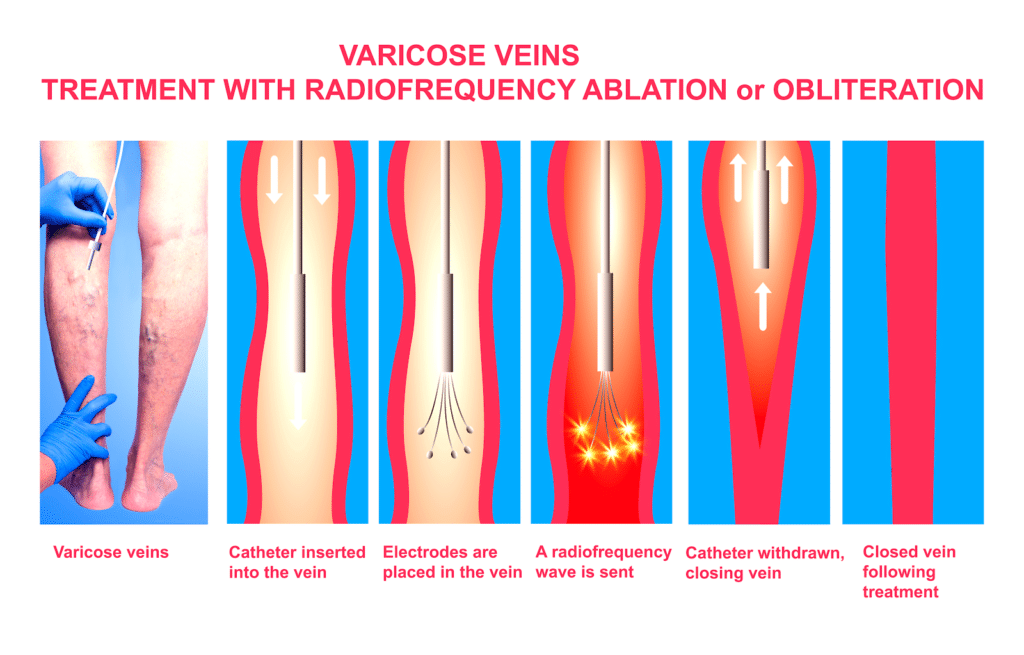
Get the Help You Need with a Vein Treatment
Call today to schedule your free consultation and see which procedure is right for you. Learn more about our practice today!
